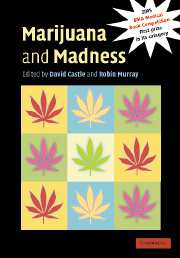Book contents
- Frontmatter
- Contents
- List of contributors
- Foreword
- Preface
- 1 The cannabinoid system: from the point of view of a chemist
- 2 How cannabis works in the brain
- 3 Acute and subacute psychomimetic effects of cannabis in humans
- 4 The association between cannabis use and depression: a review of the evidence
- 5 Cannabis and psychosis proneness
- 6 Is there a specific ‘cannabis psychosis’?
- 7 Cannabis as a potential causal factor in schizophrenia
- 8 Cannabis abuse and the course of schizophrenia
- 9 The endogenous cannabinoid system in schizophrenia
- 10 Cannabinoid ‘model’ psychosis, dopamine–cannabinoid interactions and implications for schizophrenia
- 11 Motives that maintain cannabis use among individuals with psychotic disorders
- 12 Addressing cannabis abuse in people with psychosis
- 13 Residual cognitive effects of long-term cannabis use
- Index
- References
12 - Addressing cannabis abuse in people with psychosis
Published online by Cambridge University Press: 07 December 2009
- Frontmatter
- Contents
- List of contributors
- Foreword
- Preface
- 1 The cannabinoid system: from the point of view of a chemist
- 2 How cannabis works in the brain
- 3 Acute and subacute psychomimetic effects of cannabis in humans
- 4 The association between cannabis use and depression: a review of the evidence
- 5 Cannabis and psychosis proneness
- 6 Is there a specific ‘cannabis psychosis’?
- 7 Cannabis as a potential causal factor in schizophrenia
- 8 Cannabis abuse and the course of schizophrenia
- 9 The endogenous cannabinoid system in schizophrenia
- 10 Cannabinoid ‘model’ psychosis, dopamine–cannabinoid interactions and implications for schizophrenia
- 11 Motives that maintain cannabis use among individuals with psychotic disorders
- 12 Addressing cannabis abuse in people with psychosis
- 13 Residual cognitive effects of long-term cannabis use
- Index
- References
Summary
As outlined in Chapter 8, cannabis use is common amongst people with schizophrenia and regular use, even at relatively low levels, can have a negative impact on illness course (Hall and Degenhardt, 2000). The effective management of this clinical problem is increasingly the focus of psychiatric practice and research. This chapter reviews a number of important areas that deserve consideration when developing an effective response. Aspects such as screening, assessment and models of service delivery are covered. The chapter concludes by outlining a number of psychosocial treatment interventions available for addressing cannabis use in schizophrenia and related disorders.
It must be acknowledged from the outset that there is a paucity of research evidence in terms of treatment interventions solely for cannabis use amongst people with schizophrenia. Thus, studies that have considered other drugs, and not just cannabis, are included in this review.
Screening
An awareness of any ongoing drug abuse is essential when determining psychiatric diagnosis, deciding on appropriate treatment interventions and planning future care (Zeidonis and Fisher, 1994). If undetected, drugs such as cannabis can confound the interpretation of important signs and symptoms of psychosis, possibly lead to overmanagement with psychotropic medications, as well as rendering other psychosocial treatments less effective for people with schizophrenia (Drake et al., 1993b).
- Type
- Chapter
- Information
- Marijuana and MadnessPsychiatry and Neurobiology, pp. 186 - 197Publisher: Cambridge University PressPrint publication year: 2004
References
- 2
- Cited by



